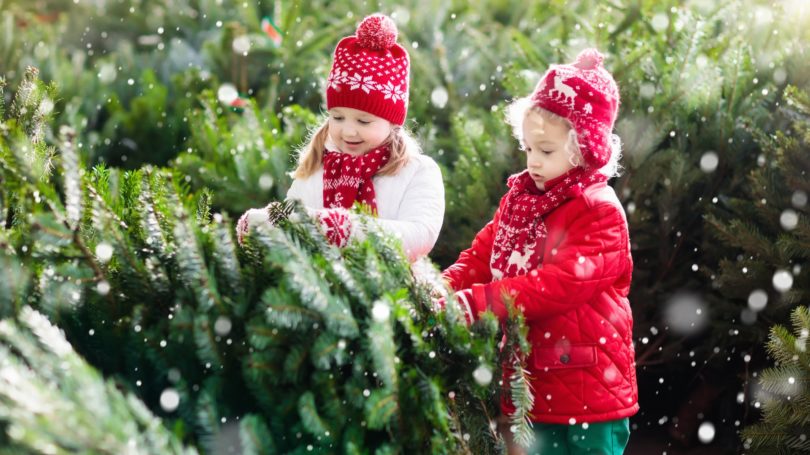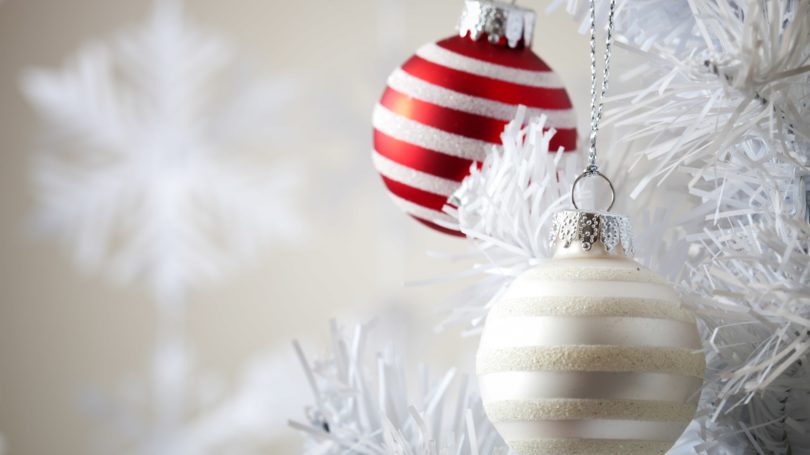Real vs. Fake Artificial Christmas Trees (Facts, Types & Comparison)
Each year around the holidays, the debate flares again: real Christmas tree or artificial tree? Which is healthier? Better for the environment? Which is better if you’re trying to save money during the holidays?
According to a survey conducted by the American Christmas Tree Association (ACTA), in 2019, 81% of Christmas trees on display in the United States were artificial, while 19% were real. Last year’s numbers show that U.S. consumers overwhelming prefer artificial trees. But real trees can evoke feelings of romance and nostalgia you just don’t get with an artificial tree.
There’s something magical about weaving your way through a maze of evergreens, breathing in the heady scent of balsam or pine while you search for just the right tree for the holidays. With that kind of imagery in mind, who wouldn’t want a real tree?
However, the answer to which type of tree is best isn’t so clear. Factors like short- and long-term cost, allergens, and environmental concerns all play a role in the decision-making process. So do what Christmas trees and the holidays mean to you and your family.
The History of the Christmas Tree
According to the History Channel, evergreen plants and trees have been revered by humans since the dawn of time. Early people hung evergreen boughs above their doors because they believed they kept away evil spirits, ghosts, witches, and illness.
Historians credit Germany with starting the Christmas tree tradition when, in the 16th century, Christians began to bring live evergreens into their homes and decorate them. The tradition was first recorded in the U.S. in the 1830s when German settlers in Pennsylvania put up trees for the holidays. However, at that time, other colonists saw the trees as pagan symbols, and it wasn’t until the 1890s that Christmas trees became popular.
According to the University of Illinois, a company called Addis Brush made the first artificial Christmas trees in the early 1930s. They were in the business of making toilet scrubbers and brushes, so the first fake trees were really nothing more than large green toilet bowl scrubbers.
Thankfully, today’s fake Christmas trees look much more realistic, and many even come decorated with Christmas lights and Christmas decorations.
Real Christmas Trees: Pros & Cons
Pros of Real Christmas Trees
Real Christmas trees can add life and a pleasant scent to your home during the holidays. But they aren’t the best choice for every family.

1. They Support U.S. Farmers
When you purchase a live tree, you’re helping support a U.S. farmer, their employees, and the local economy. According to the National Christmas Tree Association (NCTA), there are close to 15,000 Christmas tree farms located in all 50 states, and these farms employ over 100,000 people. The top Christmas tree-producing states are Oregan, North Carolina, Michigan, Pennsylvania, Wisconsin, and Washington.
Artificial trees primarily come from China, which produces 80% of all artificial trees sold in the United States. But when you buy a live Christmas tree, you’re helping people right here at home and supporting the Christmas tree industry.
2. They’re a Renewable Resource
Some people assume they’re doing the environment a favor by not cutting down a natural tree. But the NCTA also says that, on average, real Christmas trees grow seven years before they’re tall enough to cut down. That’s seven years the tree produces oxygen and reduces carbon dioxide emissions.
Each year, over 350 million Christmas trees are grown across the country on 350,000 acres of land. This land preserves green space and provides a home for birds and other wildlife. Once a tree is cut down, growers plant one to three seedlings in its place for the next year.
3. It’s Fun to Hunt for the Perfect Tree
Going out to find your own tree is fun and can help reduce and relieve holiday stress. Each tree is unique in its own way, and the time you spend finding your “perfect tree” creates memories with friends and family.
That’s especially true if you head out to a Christmas tree farm and cut down a natural tree. During the holiday season, these farms often have other attractions, like bonfires, wagon rides, caroling, and a market selling handmade or locally baked goods.
4. Live Trees Can Be Recycled
One of the biggest advantages of a natural tree is that it can be recycled at the end of the season and turned into mulch. This makes it a greener option when compared to a plastic tree, which is not recyclable.
Most cities have Christmas tree recycling programs for two to four weeks after the holidays, and many cities offer curbside pickup. Check your city’s waste and recycling website to find out if this service is offered in your area. If your city doesn’t pick up Christmas trees, there might be a drop-off service nearby. For example, New York City’s Mulchfest provides free mulch when you drop off your Christmas tree for recycling.
You can also check the website Pick Your Own Christmas Tree, which has recycling information for all 50 states.
And according to Nature, some areas use recycled Christmas trees to create fish habitats in ponds and lakes, restore streambanks, or shore up coastal dunes.
Cons of Real Christmas Trees
Despite the above pros, there are some cons of buying a real Christmas tree to consider.
1. Some People Are Allergic
Real Christmas trees carry mold spores that cause allergic reactions in some people. Potential reactions include sneezing, watery eyes, coughing, sinus congestion, shortness of breath, and an itchy nose.
Also, mold counts from live trees can be very high. A 2011 study published in the Annals of Allergy, Asthma & Immunology found airborne mold spore levels in an apartment went from 800 per cubic meter before the introduction of a live tree to 5,000 spores per cubic meter after 14 days with a live tree.
The ACTA suggests taking two steps to reduce the allergens in your tree. Before you take it inside, shake as much debris as you can out of it. Then, rinse the tree thoroughly with a water hose and leave it out to dry overnight.
Timing is also important. Allergist Dr. Lawrence Kurlandsky tells the Chicago Tribune that leaving your live tree up for only five to seven days is one of the best ways to reduce allergy symptoms. After this time frame, mold spores tend to increase dramatically.
2. They’re a Fire Hazard
If you don’t water a real Christmas tree regularly, it will dry out and become a dangerous fire hazard.
According to the National Fire Protection Association (NFPA), between 2013 and 2017, U.S. fire departments responded to a yearly average of 160 home fires that started with a Christmas tree. These fires caused an average of three deaths, 15 injuries, and $10 million in damage.
This video of a burn test conducted by the NFPA shows just how quickly a dried-out real tree catches fire and gets out of control compared to a well-watered tree, which burns much more slowly.
To prevent a home fire during the holidays, always keep a real tree well watered and make sure it’s kept well away from open flames like candles or a fireplace. Inspect all holiday lights to ensure there are no exposed wires or faulty bulbs that might cause a spark.
It’s also important to take down and recycle your Christmas tree quickly after the holidays. The NFPA reports that one-third of Christmas tree fires occur in January when trees begin to dry out.
Keep in mind that fresh trees lose a significant amount of moisture on the Christmas tree lot. A 2017 article published in For the Defense states that moisture can account for up to half the weight of the tree, and after cutting, a Christmas tree can quickly go from 100% moisture to 10% moisture. Cutting your own tree will help ensure it stays moist for a longer period of time.
Artificial Christmas Trees: Pros & Cons
Walk into retailers like Home Depot or Target during the holidays, and you’ll see row after row of beautifully decorated plastic trees. They don’t have funny shapes or holes in the branches, and you don’t have to buy one year after year. But they do come with downsides that are absolute deal breakers for some families.

Pros of Artificial Christmas Trees
1. They’re Less Work
Most people agree that artificial trees are just easier to deal with. Many artificial Christmas trees now come pre-lit, so you don’t have to spend time untangling and stringing lights. You don’t have to water them every day, and you don’t have to spend time cleaning up dropped pine needles or other foliage like you do with a real tree.
You also don’t have to worry about how you’re going to dispose of an artificial tree after Christmas since it can just be packed away and stored until next year.
2. They’re Less Expensive – Sometimes
Artificial trees are less expensive in the long term because you can reuse them each year and can last a lifetime if they’re well taken care of. The average price of an artificial tree is $100 to $200, but if you purchase one after Christmas when they’re marked down 50% to 75% or more, or if you find a used one at a thrift store, it can cost significantly less.
Real trees are purchased each year, and according to CNBC, the cost for these trees keeps going up. Prices for real trees have more than doubled since 2008. In 2019, the average cost for a real tree was $76.
Costs for real trees keep climbing for several reasons. Wildfires and hurricanes have affected tree farmers in recent years, and many farmers are leaving the industry. Good Morning America reports that in Oregon, the top Christmas tree-producing state in the nation, there were 699 registered tree farms in 2010, but by 2018, this number had gone down to 392. CNBC reports that Christmas tree production has fallen 33% since 1977.
3. They Look Realistic
Artificial trees have come a long way since they were first introduced in the 1930s. Today’s plastic trees look exactly like the real thing.
Balsam Hill, a California-based company selling handcrafted artificial trees, has been featured on many leading shows, such as The Today Show and ABC News, because their trees are so realistic. Even the fake Christmas trees carried by retailers like Lowes or Amazon look like the real thing. And because these trees can be reused each year, they can be a more affordable option long-term.
Cons of Artificial Christmas Trees
1. They’re Unhealthy for You
Manufacturers make artificial trees with polyvinyl chloride (PVC) plastic, aluminum, and steel. PVC plastic is fire-resistant but can contain especially harmful chemicals, like arsenic, lead, and phthalates, which are recognized endocrine disruptors.
Lead is dangerous for anyone, but it’s particularly harmful to young children, who are often tempted to put tree fronds in their mouths. A 2004 study published in the Journal of Environmental Health found artificial trees containing lead were in up to 50 million American homes. Researchers studying the toxicity of these artificial trees found that while the average artificial tree does not present a significant exposure risk, in the worst-case scenario, the exposure risk for young children was quite substantial.
And it’s almost impossible to know which chemicals are in your artificial tree because there’s so little oversight.
Men’s Health interviewed Dr. Bruce Lanphear, professor of health sciences at Simon Fraser University, who said that over three-quarters of chemicals used in consumer products have not been sufficiently tested for toxicity, so they’re assumed to be safe. But that’s a big assumption, especially when you’re dealing with chemicals in products coming from China, where there’s even less oversight than the United States.
Artificial trees, when new, release volatile organic compounds (VOCs) that over the short term can cause headaches, dizziness, eye, and respiratory tract irritation. Over the long term, they can cause fatigue and nausea, as well as damage to the liver, kidneys, and central nervous system. The emissions can even cause cancer.
You can reduce the VOCs in a new tree by taking it out of the box and leaving it outside to air out as long as possible.
2. They’re Bad for the Environment
Artificial trees have a big carbon footprint because they’re produced in a factory and then travel by ship, plane, and truck to big-box stores in the United States. There’s also the cardboard packaging needed to box up the tree.
While real trees can be recycled, artificial trees can’t. Ultimately, they end up in a landfill. According to The Guardian, a 6.5-foot tree has a carbon footprint of about 88.18 pounds of greenhouse gas emissions. That’s more than twice that of a live tree.
The Los Angeles Times interviewed William Paddock, the managing director of WAP Sustainability Consulting in Chattanooga, Tennessee. He says real trees use fewer resources overall to get into the hands of consumers. However, artificial trees can make less of an environmental impact if you use them at least six to nine years before buying another one.
3. They’re a Fire Hazard
Dried-out real Christmas trees are an obvious fire hazard, but so are artificial trees. Over time, artificial trees collect dust, which can be highly flammable. Although manufacturers spray them with fire retardants, they can still ignite.
Final Word
If you just look at the numbers, it’s clear that choosing an artificial tree is less expensive over time than choosing a real tree. And they definitely require less work. However, real trees don’t contain harmful chemicals like lead or fire retardants, and they evoke more of the sense of the holiday for some people because they smell so good.
If you’re balking at the price of a real Christmas tree, you’ll pay less if you wait. PBS reports that prices for real trees are lowest the week before Christmas, with the absolute lowest prices on Christmas Eve.
Whichever tree you choose, decorating it with family and friends can be a fun way to reduce stress around the holiday season. And ultimately, what matters most is spending time with those you love.
Published at Mon, 30 Nov 2020 18:00:29 +0000





Comments
Loading…